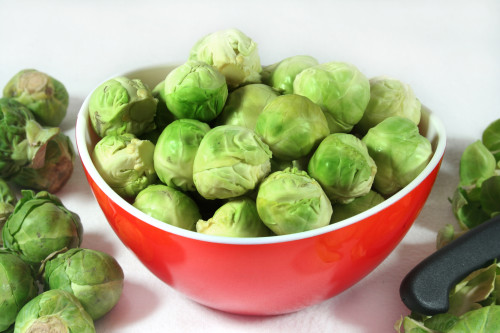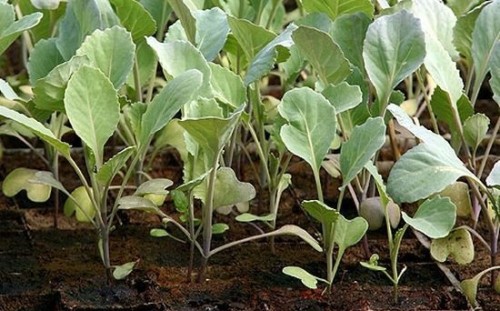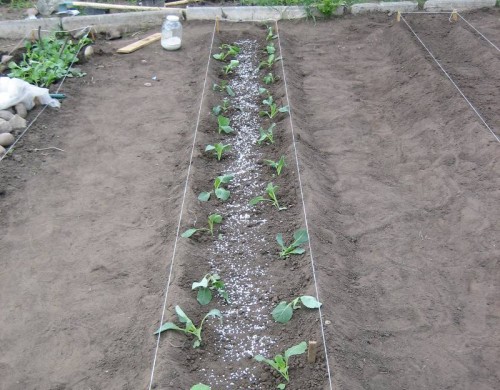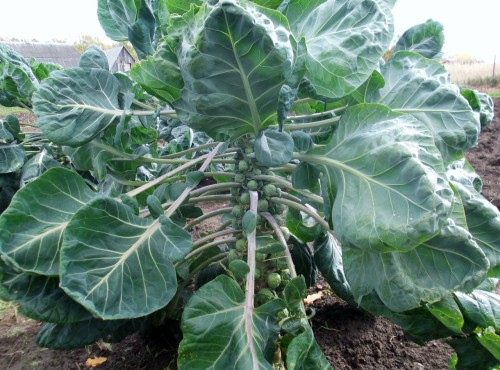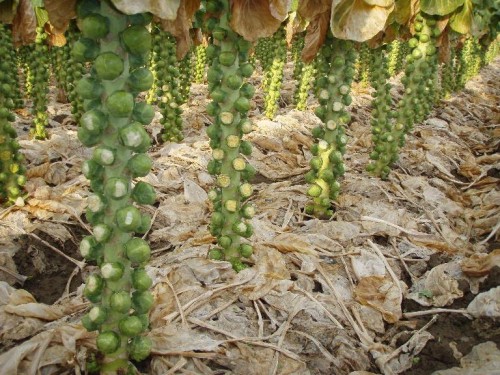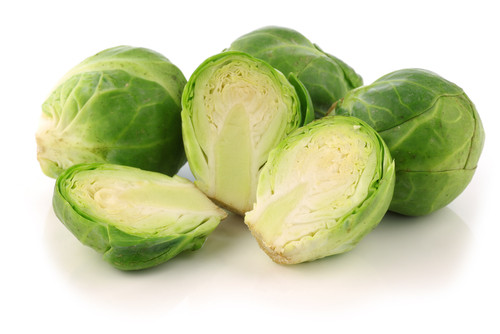Similar to nuts, Brussels Kooms can rather be seen in supermarkets, and in our sites this overseas guest is rarely falling across. For some reason, houses are indifferent to her, many do not even imagine how it looks, and in vain, because in other types of cabbage there are no vitamins, as in it. After reading the article, you will learn what is the value of Brussels Cabbage, about its cultivation, care for her.
Content
About the benefits of Brussels cabbage
Brussels Cabbage, the photo below, is green and purple, and the last knockers are smaller, but both are useful.
The miniature balls of Brussels cabbage contain almost the same set of vitamins as its nearest relatives, but in percentage of their significantly more:
- vitamin C, which remains preserved during processing and storage is more than 3-5 times. The same amount is also in currant black;
- other vitamins - RR, A, B1, B2, B5, B6, B9, E, and exceeding their content in other types of 2 to 3 times.
There are in it and mineral salts: iodine, potassium, iron, phosphorus, sodium, potassium, calcium, sugar, fiber, starch, amino acids, enzymes, crude protein. Moreover, it is 5 times more in it than in the usual, and color exceeds in this indicator 3 times, and in quality it is equal to meat and dairy, which is very rarely found in plants.
American scientists identified the most useful property of the Brussels cabbage - to prevent such types of oncological diseases such as lung cancer, uterus, breasts due to the content of active anti-aging substances in successful proportions, which indoles, phytonutrites and folates are. The juice of Brussels Cabbage, as an amplifier of the pancreas function.
BRUSHINE CURRUSHING SECRETS
Brussels Cabbage during the cultivation requires the same techniques as the cultivation of other representatives of the sow of cabbage, but still has its own characteristics:
- First, it is a very frost-resistant culture. Seedling some of its varieties feels well at -7 degrees C, and even -10 adult plants are acceptable.
- Secondly, very loves light. If it is sharpened, then kochannels can not get involved.
- Thirdly, it is easier than other cabbage tolerate the lack of moisture, although somewhat reduces the yield.
- Fourthly, she needs exclusively fertile soil. On poor soils, it is poorly developing, kerises, if it takes, it is very late. On acidic soils do not grow at all.
Growing seedlings
All varieties of this cabbage have a long growing season - from 160 to 180 days. For this reason, the cultivation occurs for Brussels cabbage mainly through seedlings. The optimal duration of planting seeds - mid-March. The algorithm is as follows:
- Having bought untreated seeds, for disinfection, we lower in the water with a temperature of + 50 ° C for 20 minutes, then immediately minutes to 2 in the cold.
- We dry until it is bulk.
- Immediately before planting, we repeat the soaking procedure and harde the planting material at a temperature of about +2 ° C for a day.
- Fill the pot or boxes with a height of 50 mm fertile soil mixture, water, sowing seeds.
- We place the containers on the windowsill, where the temperature is kept at the level of 18 to 20 ° C. After 5 days, when cabbage rises, another set temperature conditions - high + 9 ° C.
- We water, we carry out, we remove weak plants, feed.
- Swooping seedlings after 2 weeks and regularly Feeding the. We do this 3 times:
- a week after a dive, dissolving potash fertilizers and ammonium nitrate for 2 g and 4 g of superphosphate;
- 14 days after the first procedure, the same composition, but we double the concentration of the solution;
- 2 days before landing on the bed, mixing the ammonium saltper, superphosphate, potash fertilizers with a liter of water 3, 5, 8 g, respectively.
If there is a lot of seedlings, then the seeds are better to fall into the greenhouse or greenhouse, adhering to the following rules:
- distance between lines - 8 cm;
- sowing rate - 5 seeds per 1 m;
- the depth of the well - 10 mm.
We send seedlings to the garden at the incident of 1.5 months after sowing seeds when it already has 4-5 real sheets. This is usually the end of May.
Cooking Groke
Preparation should be started from autumn. At the same time, do not forget that the Brussels cabbage grows well after beets, tomatoes, onions, cucumbers, potatoes. The soil prefers a loamy, the place is well lit. By choosing a suitable area for these parameters, start to prepare a garden:
- We remove weeds, deeply leaving.
- We introduce compost or manure, just not fresh - 5 kg per 1 square meter. m, Mineral fertilizers at the rate of 1 square. M:
- nitrogen - 10 g;
- phosphorus-containing, preferably simple and double superphosphate - 8 g;
- potasy is better to contain sodium, i.e. Sulfate Potassium, Selith Potashnya - 12 g.
Three steps to a good crop
- Before planting seedlings, the beds are fertilized by making a mixture with a stuffing with wood ash - by 1 sq. M Bucket of humus and politone bank of ash.
- Making wells at a distance of 0.6 m in relation to each other. The same distance is left between the rows.
- We water moderately, not allowing soil the soil.
Care for Brussels cabbage
It does not require a Brussels cabbage of excessive care, but it will not grow in itself. To get an abundant harvest in the form of tight, normal sizes of nuts, some nuances are needed:
- 2 weeks after disembarking cabbage to a permanent place, when the plants are growing noticeably, adopt their poultry litter in the ratio of 1:10 or a cow-1: 6, or alive - 1: 4. Mineral fertilizers are suitable - nitrogen 25 g, how much potassium and 20 g of phosphorus.
- When nomads begin to form, make another feeding, with the amount of nitrogen and potassium increase in 5 g.
- In order to protect against pests, loosen the soil weekly and sprinkle it ash.
- To give an impetus to the growth of Kochanchikov, at the end of August, when they will like to resemble a pea, cut the top kidney on plants, and at the end of September or beginning of October, remove completely tops with underdeveloped stress kidneys.
- If we noticed that cabbage flies began to attack the plants, pull the grid over the bed until she put the eggs.
- When yellow leaves are yellow, it says that plants lack nitrogen. Save the position by adding horny flour.
Important: Never plunge the Brussels Cabbage. This will lead to the boosts of the kochanchikov.
Remove the crop
The harvest of the Brussels cabbage, the cultivation and care of which occupies a fairly long period - from March to October, spend in several techniques as nuts ripening when they become dense, shiny, and in diameter it will reach 30 mm. Special taste is the harvest, assembled during frosts.
How to save grown
When the question is how to grow Brussels, resolved, the second occurs - how to keep the harvest? Each host has its own solution:
- Save this type of cabbage mainly in a frozen form, while re-frost is invalid. For some time she can lie down and just in the refrigerator placed in a plastic bag.
- There is another way to storing the Brussels cabbage - right on the bed along with the stem. The leaves do not need to cut down, they will serve as shelter for kochenchikov. Pynik also serves as an additional insulation - some gardeners are covered with cabbage palm trees. Of course, a long cabbage will not last, only up to -10 ° C.
- When the cabbage is not completely removed, and the big frosts are already on the threshold, tilt the plants and cover the insulation all the beds or enhance everything with the roots and lower in the basement, sprinkled with the roots of sand.
Enter on your beds this is a wonderful plant. It will decorate them, and will provide you with vitamins, minerals and you will become less ill, and besides - dishes from Brussels cabbage will bring a variety of in your diet, and you will definitely like them. To convince you of this will try the author of this video:



